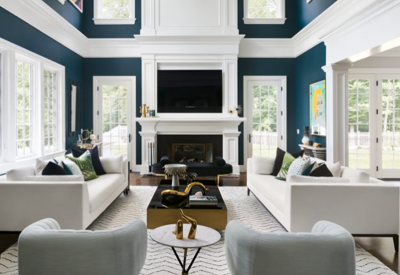
Ever walked into a beautifully designed room and thought, Why does this feel so right? You might not be able to pinpoint it at first, but chances are, a subtle principle is at work behind the scenes: the Rule of Three. It’s a timeless design guideline used by interior designers, stylists, and even visual merchandisers to create balance, harmony, and visual interest in a space.
Whether you're decorating a coffee table, arranging pillows on a sofa, or curating a gallery wall, the Rule of Three is one of the easiest tricks to instantly elevate your style. It’s not just about counting objects—it’s about creating rhythm and contrast that feels natural to the eye.
If you’ve ever struggled to make your home decor look polished without being overdone, understanding this simple concept can be a game-changer. You don’t need a design degree to apply it—just a bit of guidance, practice, and some thoughtful inspiration. For real-life applications and decorating strategies, browsing resources like https// :decoratoradvice.com can help you visualize how this design rule works across different rooms and styles.
Why Three Works
There’s something inherently pleasing about odd numbers in design—particularly the number three. Our brains are wired to recognize patterns, and odd-numbered groupings feel more dynamic and less rigid than even ones. Three creates just enough variety to be visually interesting without overwhelming the senses.
In design, this often translates to balance. A group of three items forms a triangle, which naturally draws the eye across a space. That’s why things grouped in threes—like vases, frames, or cushions—tend to look intentional and balanced, while pairs or fours can sometimes feel stiff or overly symmetrical.
Apply It to Groupings
One of the easiest ways to use the Rule of Three is in tabletop styling or shelf arrangements. Think of a console table with three elements: a tall lamp, a medium-height vase, and a small stack of books. Varying height and shape is key—this prevents the arrangement from looking too uniform.
On a coffee table, you might have a tray with three items: a candle, a small plant, and a decorative bowl. Even if they’re totally different in style, placing them together thoughtfully creates a mini vignette that feels cohesive.
Don’t forget about vertical groupings too—like a set of three wall hooks, framed prints, or pendant lights. The same rule applies: odd numbers create flow, and spacing matters just as much as the items themselves.
Decorate with Odd Numbers Beyond Three
While three is the most commonly used number in this design principle, the broader concept is known as the Rule of Odds. Groups of five or seven can also look fantastic, especially in larger spaces like a gallery wall or a built-in bookshelf. The same idea applies: odd numbers are more visually stimulating and less predictable.
Just be mindful of scale. Five throw pillows on a small sofa can feel cluttered, but five large framed photos on a spacious wall might feel perfectly balanced.
Mix Textures, Shapes, and Heights
The Rule of Three isn’t just about counting—it’s about creating variation. When grouping decor, mix textures (wood, glass, metal), shapes (round, square, organic), and heights to build dimension.
Let’s say you’re styling a mantel. Start with a tall candlestick, add a mid-height framed photo, and finish with a small sculpture or greenery. The variation in form and scale keeps the arrangement from feeling flat or monotonous.
Even when using a monochromatic color palette, texture can keep things interesting. Three white objects of different materials—like ceramic, stone, and linen—will still feel rich and intentional.
Use It in Furniture Arrangement
This principle isn’t just for accessories—it applies to larger elements too. Consider three seating pieces in a living room: a sofa and two accent chairs. Or three light sources in a room: overhead lighting, a floor lamp, and a table lamp. These groupings create functional and visual balance that feels complete without being cluttered.
You can also apply it to dining or kitchen design. A set of three pendant lights over a kitchen island not only provides adequate lighting but also follows this pleasing rule of balance and spacing.
Break the Rule—When It Feels Right
Like all design guidelines, the Rule of Three is a tool, not a law. Once you understand why it works, you can break it intentionally. Some minimalist spaces shine with only two perfectly chosen elements. Others thrive in deliberate symmetry. The difference is knowing why you’re choosing a certain arrangement, not just guessing at what looks good.
Experiment and trust your eye. Use the Rule of Three to guide your decisions, especially when you feel stuck or your space feels off. But don’t let it box you in.
Make It Your Own
The beauty of the Rule of Three is that it works in every style—from modern to rustic to eclectic. It’s adaptable and forgiving, making it a great go-to for beginners and seasoned decorators alike.
Start small. Style a shelf. Arrange your coffee table. Play with textures and scale. As you get more confident, you’ll start to see how this principle quietly brings order and ease to your whole space.
Because in the end, decorating is about creating an environment that makes you feel at home—and sometimes, all it takes is three well-chosen pieces to do just that.


(0) comments
We welcome your comments
Log In
Post a comment as Guest
Keep it Clean. Please avoid obscene, vulgar, lewd, racist or sexually-oriented language.
PLEASE TURN OFF YOUR CAPS LOCK.
Don't Threaten. Threats of harming another person will not be tolerated.
Be Truthful. Don't knowingly lie about anyone or anything.
Be Nice. No racism, sexism or any sort of -ism that is degrading to another person.
Be Proactive. Use the 'Report' link on each comment to let us know of abusive posts.
Share with Us. We'd love to hear eyewitness accounts, the history behind an article.